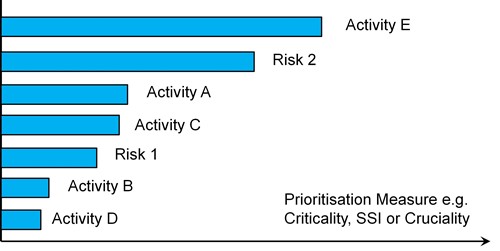A brief guide
Practical Project Risk Management
SERIES ARTICLE
By Martin Hopkinson
United Kingdom
Purpose
Use the statistical outputs of Schedule Risk Analysis (SRA) to identify the activities and risks likely to have the greatest influence on a project’s schedule performance. This guidance should be read in conjunction with the Schedule Risk Analysis guidance sheet (May, 2023)
Displaying SRA Prioritisation Results with Tornado Charts
A Monte Carlo schedule risk model comprises a network of activities and risk events that can be used to simulate variations of schedule duration. These activities and risk events, together with their associated estimates generate inputs to the model. When the model has been used to perform a Monte Carlo simulation, its outputs can be used to create Tornado charts using a variety of different measures.

The lengths of the tornado chart bars indicate the relative influence that the model’s activities and risk events are likely to have on overall schedule performance. The longest bars identify the activities and risks that are the most significant.
SRA Prioritisation Measures
Criticality: The probability that an activity or risk event will be schedule-critical, measured as the percentage of iterations in the simulation during which it impacts on the critical path. (Note that risk events should not have a criticality that exceeds their probability of occurrence).
Schedule Sensitivity Index (SSI): The product of the activity’s criticality and standard deviation, divided by the standard deviation for the variability of the final milestone. This measure improves upon criticality by also taking into account the variance of activity and risk event outcomes. (Note that the standard deviation of each risk event should take into account its whole PDF, including outcomes in which the risk does not occur).
Cruciality: The correlation between the duration outcome of an activity or risk event and the date of the project’s end milestone or a selected interim milestone. (Note that cruciality results should be produced by running a version of the model without correlation inputs).
More…
To read entire article, click here
Editor’s note: This series of articles is by Martin Hopkinson, author of the books “The Project Risk Maturity Model” and “Net Present Value and Risk Modelling for Projects” and contributing author for Association for Project Management (APM) guides such as Directing Change and Sponsoring Change. These articles are based on a set of short risk management guides previously available on his company website, now retired. For an Introduction and context for this series, click here. Learn more about Martin Hopkinson in his author profile below.
How to cite this article: Hopkinson, M. (2023). Schedule Risk Analysis Prioritization Results: A brief guide, Practical Project Risk Management series, PM World Journal, Vol. XII, Issue VI, June. Available online at https://pmworldlibrary.net/wp-content/uploads/2023/05/pmwj130-Jun2023-Hopkinson-schedule-risk-analysis-prioritisation-results-risk-management.pdf
About the Author

Martin Hopkinson
United Kingdom
![]()
Martin Hopkinson, recently retired as the Director of Risk Management Capability Limited in the UK, and has 30 years’ experience as a project manager and project risk management consultant. His experience has been gained across a wide variety of industries and engineering disciplines and includes multibillion-pound projects and programmes. He was the lead author on Tools and Techniques for the Association for Project Management’s (APM) guide to risk management (The PRAM Guide) and led the group that produced the APM guide Prioritising Project Risks.
Martin’s first book, The Project Risk Maturity Model, concerns the risk management process. His contributions to Association for Project Management (APM) guides such as Directing Change and Sponsoring Change reflect his belief in the importance of project governance and business case development.
In his second book Net Present Value and Risk Modelling for Projects he brought these subjects together by showing how NPV and risk modelling techniques can be used to optimise projects and support project approval decisions. (To learn more about the book, click here.)
To view other works by Martin Hopkinson, visit his author showcase in the PM World Library at https://pmworldlibrary.net/authors/martin-hopkinson/









